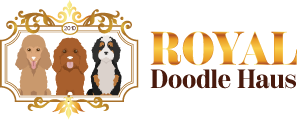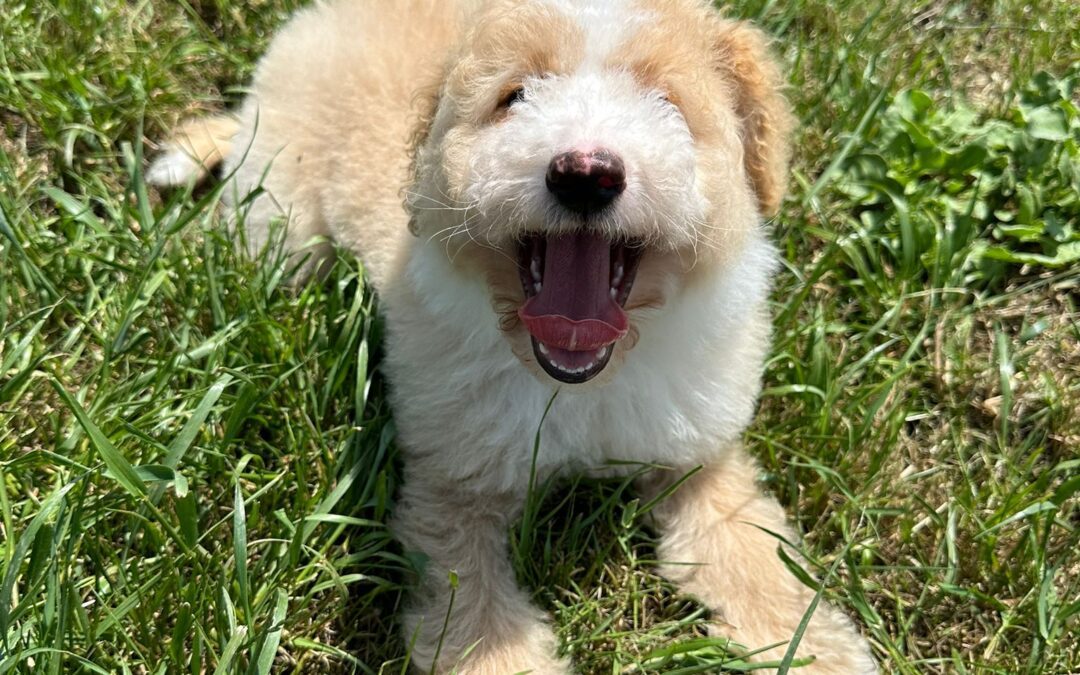As a kennel owner who’s been breeding Poodles and Doodles for over two decades, I’ve seen my fair share of puppy teeth come and go. Let me tell you, there’s nothing quite like watching a litter of Poodle puppies grow from toothless little beans to adults with full sets of pearly whites. It’s a journey, and today we’re going to walk you through our Poodle puppy teething timeline, step by step.
Why Should You Care About Puppy Teeth?
Now, you might be wondering, “Why does this matter? They’re just baby teeth, right?” Well, let me tell you a quick story. A few years ago, I was consulted by a customer over their 8-month-old Aussiedoodle, Floyd. Poor Floyd had been drooling and off his food for days. Turns out, he had several retained puppy teeth causing all sorts of problems. If his owners had known what to expect, they could have caught it earlier and saved Floyd a lot of discomfort (and themselves a hefty vet bill).
Understanding your Poodle puppy’s dental milestones isn’t just about satisfying curiosity — it’s about being a responsible pet owner and ensuring your furry friend’s health and comfort.
Poodle Puppy Teeth: The Basics
Before we dive into the timeline, let’s cover some basics.
How Many Teeth Do Puppies Have?
Poodle puppies, like all dogs, start with 28 deciduous teeth (also known as milk teeth or baby teeth). As adults, they’ll end up with 42 permanent teeth. That’s quite the upgrade!
What’s the Purpose of Puppy Teeth?
Puppy teeth serve a few important purposes:
- They help puppies transition from nursing to eating solid food.
- They’re placeholders, guiding the adult teeth into the right positions.
- They help puppies learn about their environment (though our furniture might wish they didn’t).
The Teething Timeline for Poodle Puppies
Let’s break down the teething process, step by step.
Birth to 2 Weeks: The Gummy Stage
Newborn Poodle puppies are toothless wonders. They’re focused on nursing and sleeping at this stage. Enjoy the gummy smiles while they last!
2-4 Weeks: Here Come the Baby Teeth!
Around 2-4 weeks, you’ll start to see tiny teeth poking through. The incisors usually come in first, followed by the canine teeth.
5-8 Weeks: Full Set of Puppy Teeth
By about 8 weeks, your Poodle puppy should have all 28 of their deciduous teeth. This is typically when we start to send puppies to their new homes, and let me tell you, those little teeth are sharp! I always warn new owners to be prepared for some playful nipping.
12-16 Weeks: The Great Tooth Migration Begins
Around 3-4 months old, Poodle puppies start losing their baby teeth. The incisors are usually the first to go. You might find tiny teeth around the house, or you might not—puppies often swallow them, which is completely normal.
4-6 Months: The Big Switch
This is when the majority of the teething action happens. Your Poodle puppy will be losing puppy teeth and gaining adult teeth at a rapid pace. It’s like a conveyor belt of teeth in there!
7-8 Months: The Finish Line
By 7-8 months, your Poodle should have all 42 of their adult teeth. Congratulations, you’ve made it through the teething phase!
Signs Your Poodle Puppy Is Teething
How can you tell if your puppy is in the thick of teething? Here are some signs to watch for:
- Increased chewing behavior: If your puppy suddenly starts gnawing on everything in sight, teething is likely the culprit.
- Mild bleeding or swollen gums: Don’t panic if you see a little blood on your puppy’s toys. A small amount of bleeding is normal during teething.
- Drooling: Some puppies drool more than usual when they’re teething.
- Reluctance to eat hard food: Sore gums can make crunchy kibble less appealing.
- Visible gaps in the teeth: You might notice spaces where teeth have fallen out.
I remember one Poodle puppy, Bea, who would leave tiny bloodstains on her white blanket. Her owner was terrified, thinking Bella was hurt. Turns out, she was just losing her puppy canines!
Caring for Your Teething Poodle Puppy
Teething can be uncomfortable for puppies, but there are ways you can help:
Provide Appropriate Chew Toys
Offer a variety of textures — rubber toys, rope toys, and soft plush toys. Some puppies love frozen washcloths or specially designed teething toys you can chill in the fridge.
Introduce Dental Care Routines
It’s never too early to start good dental habits. Use a finger brush or gauze pad to gently clean your puppy’s teeth and gums. This gets them used to having their mouth handled, making future dental care easier.
Adjust Food if Necessary
If your puppy is struggling with hard kibble, you can soften it with a bit of warm water.
Soothe Sore Gums
Gentle gum massages can provide relief. Just be careful — those new teeth are sharp!
Potential Dental Issues to Watch For
While teething is a normal process, there are a few issues to keep an eye out for:
Retained Deciduous Teeth
Sometimes, puppy teeth don’t fall out when they should. This can lead to overcrowding and misalignment of adult teeth. If you notice a puppy tooth still in place with an adult tooth growing beside it, it’s time for a vet visit.
Misaligned Teeth
Poodles, especially Toy and Miniature varieties, can be prone to misaligned teeth. Regular check-ups during the teething period can catch and address these issues early.
Fractured Teeth
Puppies can sometimes fracture their teeth on hard objects. Stick to appropriate chew toys to minimize this risk.
Poodles vs. Doodles: Any Differences?
Now, I know some of you might be wondering if there’s any difference in the teething process for Poodles versus Doodles. In my experience, the timeline is generally the same. However, depending on the other parent breed in a Doodle, you might see some variations in tooth size or potential dental issues.
For instance, I’ve noticed that Goldendoodles sometimes have slightly larger teeth than pure Poodles, likely due to the influence of the Golden Retriever genes. But when it comes to the teething process itself, it’s pretty much the same across the board.
When to Consult a Veterinarian
While teething is a normal process, there are times when you should seek professional help:
- If your puppy seems to be in excessive pain
- If you notice any broken teeth
- If adult teeth are coming in but the puppy teeth aren’t falling out
- If there’s excessive bleeding or swelling
- If your puppy’s breath is particularly foul (some odor is normal during teething, but excessive bad breath could indicate a problem)
I always recommend that my clients schedule a check-up around 6 months of age, just to make sure everything is progressing as it should.
Wrapping Up
And there you have it, folks — the ins and outs of the Poodle puppy teething timeline. Remember, every puppy is unique and might not follow this timeline to the day. The key is to be patient, provide lots of appropriate chew toys, and keep an eye out for any potential issues.
Teething can be a challenging time for both puppies and their owners, but it’s also an exciting period of growth and development. Before you know it, your little pup will have a full set of adult teeth, ready to flash that winning smile that we all know and love.
Now, if you’ll excuse me, I’ve got a litter of 6-week-old Standard Poodle puppies who are just starting to show their puppy teeth. Time to break out the teething toys!

